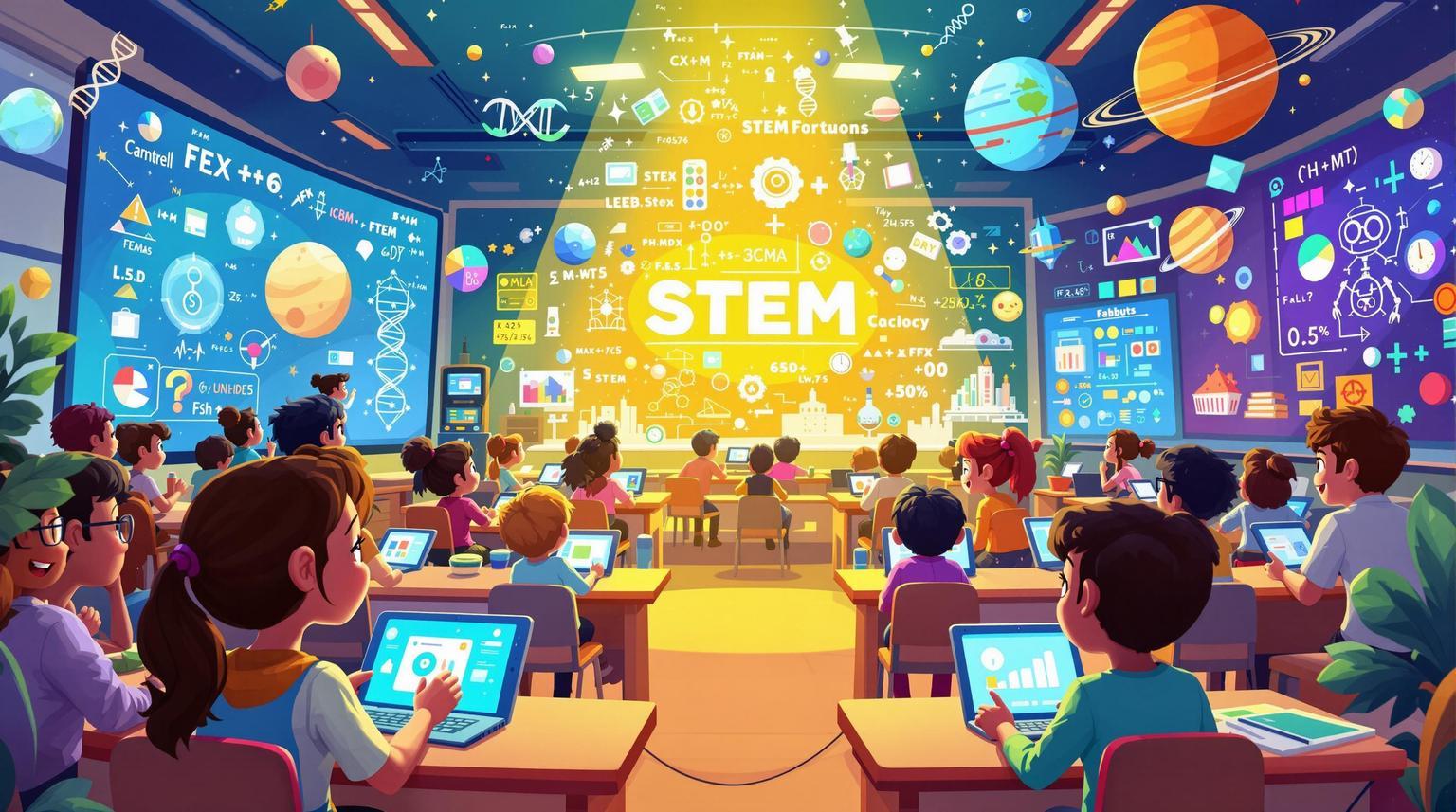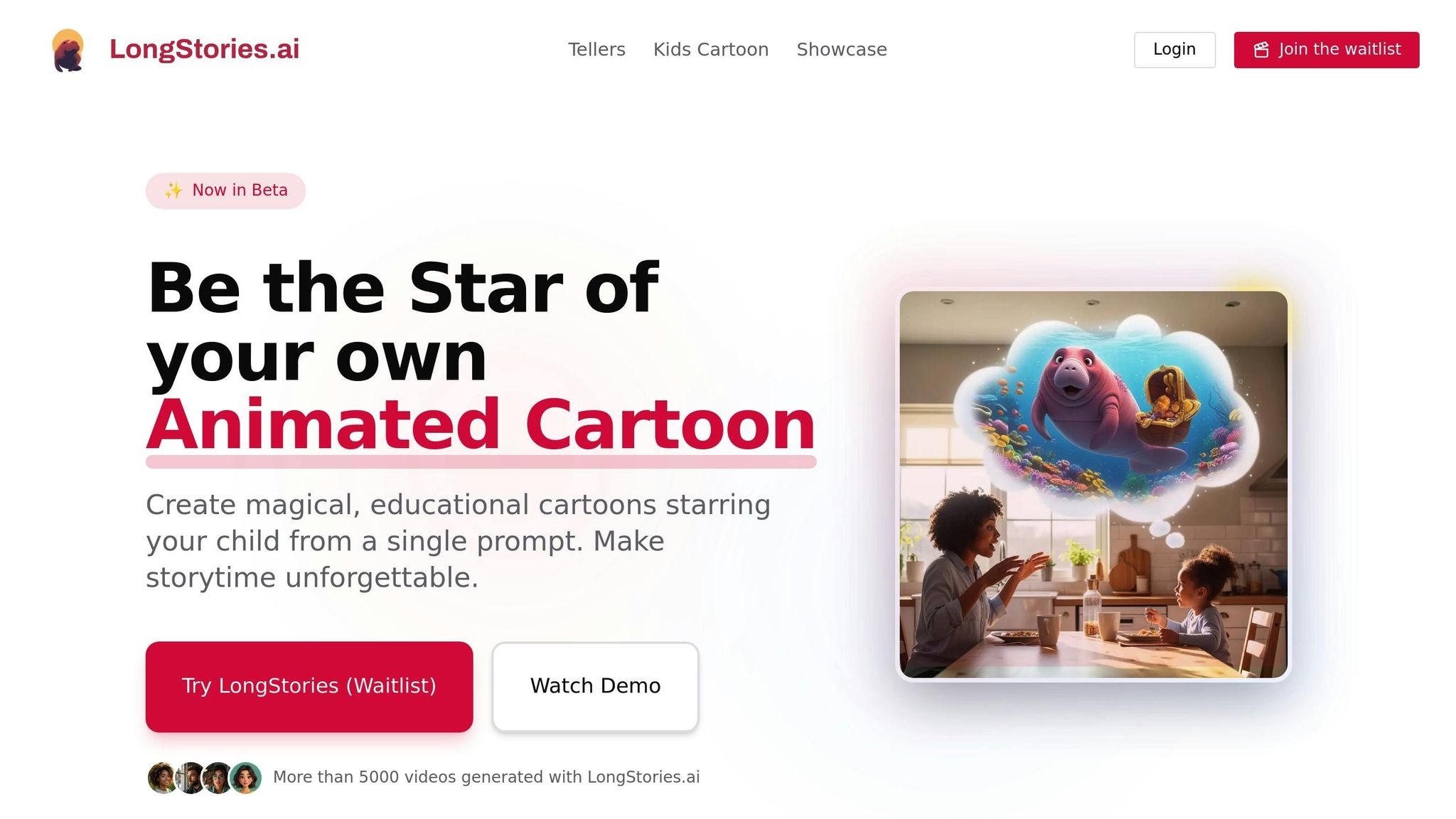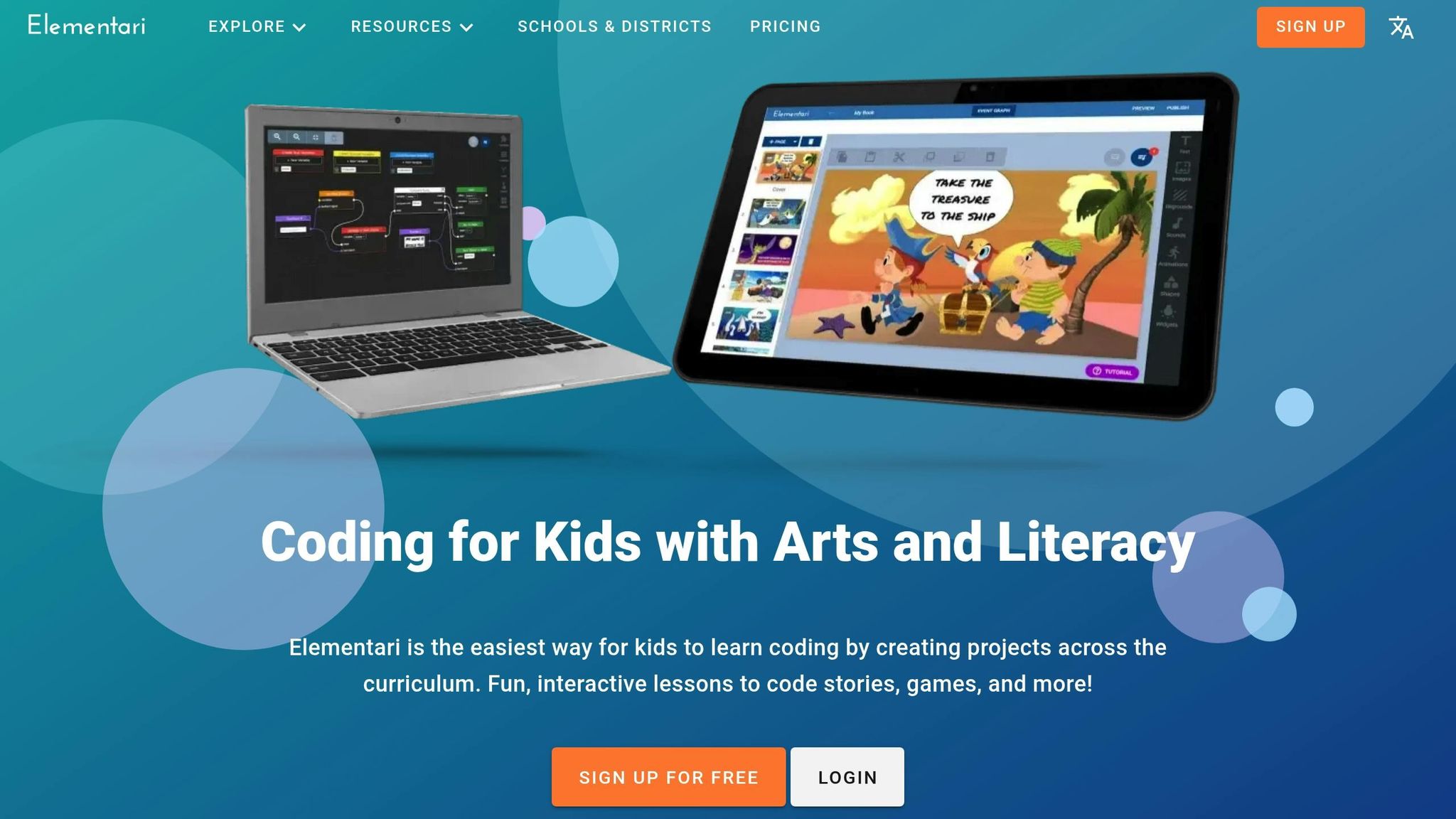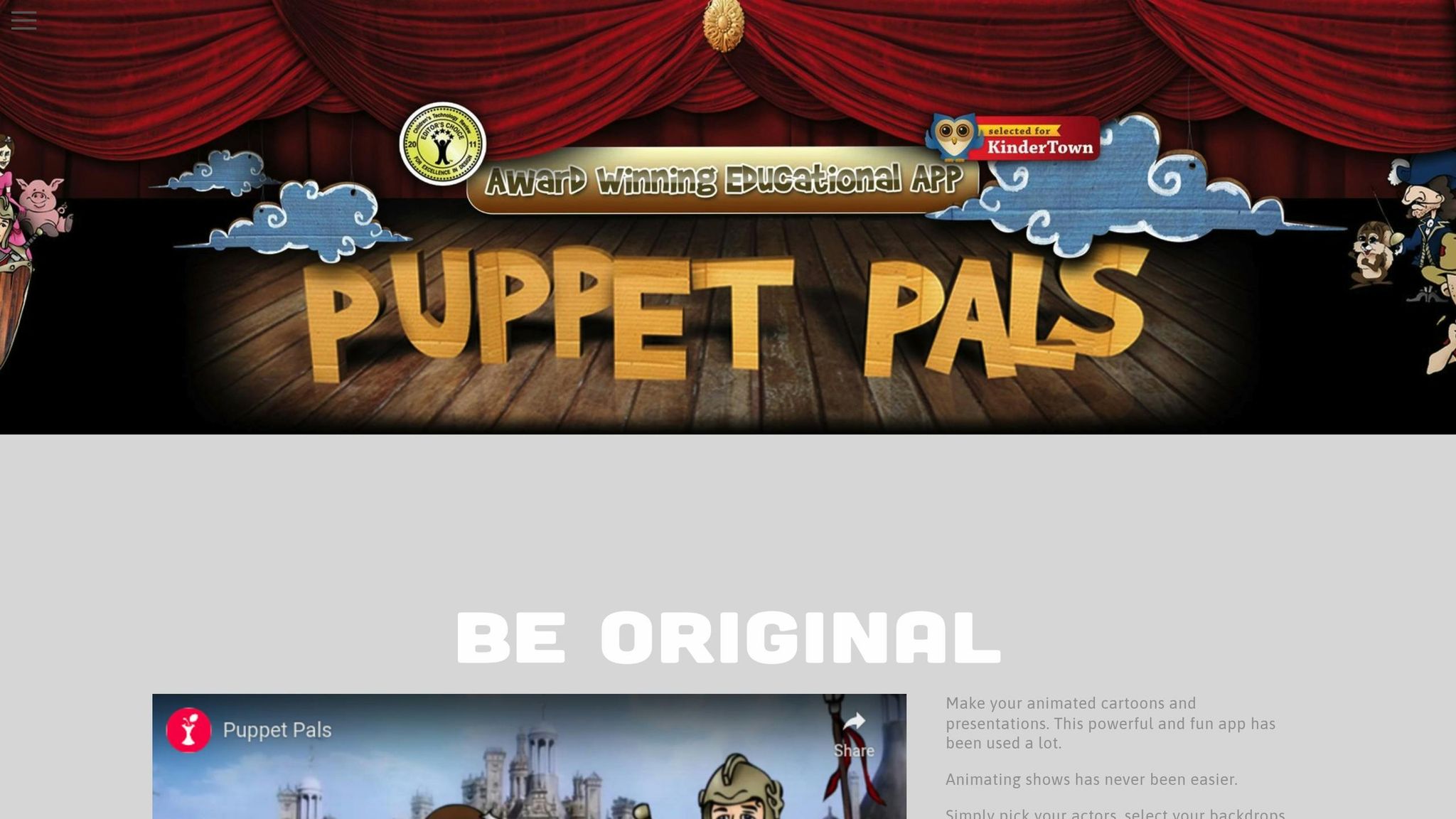
LongStories is constantly evolving as it finds its product-market fit. Features, pricing, and offerings are continuously being refined and updated. The information in this blog post reflects our understanding at the time of writing. Please always check LongStories.ai for the latest information about our products, features, and pricing, or contact us directly for the most current details.
STEM Learning Through Digital Storytelling Tools
Want to make STEM learning fun and engaging? Digital storytelling tools are transforming how students understand complex topics like coding, math, and science.
Here’s how these tools help:
- Knight Lab Storytelling Suite: Turns data into interactive stories using tools like timelines and maps.
- LongStories.ai: Creates personalized animated videos in under a minute, starring the student as the main character.
- Elementari: Combines coding and storytelling with drag-and-drop tools for students from K-12.
- Puppet Pals HD: A free app where students create animated stories to explain STEM ideas visually.
Each tool brings unique features to the table, from personalized learning to coding integration, making STEM concepts easier to grasp. Whether you’re a teacher or parent, these platforms offer creative ways to connect students with STEM subjects.
Quick Comparison
| Tool | Key Feature | Best For | Cost | Ease of Use | Device Compatibility |
|---|---|---|---|---|---|
| Knight Lab | Data storytelling tools | Middle/High School | Free | Moderate | Browser-based |
| LongStories.ai | Personalized animated videos | Younger Students | Beta (Free) | Easy | Browser-based |
| Elementari | Coding + storytelling integration | Elementary/Middle School | $8-$99/month | Moderate | Browser-based |
| Puppet Pals HD | Simple animated storytelling | All Grades | Free | Easy | iOS devices |
These tools cater to different age groups, budgets, and technical needs, ensuring there’s something for every classroom or home learning environment.
STEM Through Stories
1. Knight Lab Storytelling Suite

The Knight Lab Storytelling Suite, developed by Northwestern University’s interdisciplinary team, is a platform designed to push the boundaries of journalism and storytelling. As Knight Lab describes it, "Northwestern University Knight Lab is a community of designers, developers, students, and educators working on experiments designed to push journalism into new spaces". Their goal is to create "easy-to-use tools that can help you tell better stories".
STEM Integration
Knight Lab connects technical concepts with storytelling in a way that makes complex ideas more approachable. For instance, their StorylineJS tool allows educators to "tell the story behind the numbers", turning data and mathematical concepts into narratives that are easier for students to grasp. This approach brings abstract STEM topics to life, making them more engaging and relatable.
The lab’s experimental projects also showcase practical STEM applications. One example is their SensorGrid prototype, which uses a wireless sensor network to teach environmental science concepts. This system focuses on web API design and data management, offering students a chance to explore how sensors collect data and how that information can be used to tell meaningful stories.
Another project, Reporter's Workbench AI, introduces artificial intelligence and machine learning to students. This desktop web app, powered by OpenAI, helps convert notes into actionable tasks, perform web searches, and query datasets. By using the tool, students gain insight into how AI processes information while crafting their own data-driven stories.
Interactivity
Knight Lab’s suite is packed with interactive tools that help students create dynamic and engaging narratives. Tools like TimelineJS, StoryMapJS, and JuxtaposeJS make it easy to combine text, images, videos, audio, and other interactive elements into a single story.
For example, students can use TimelineJS to create timelines of scientific breakthroughs, StoryMapJS to explore geographic data, or JuxtaposeJS to compare before-and-after scenarios in environmental studies. A notable example is the "1918 Flu Pandemic in Utah" exhibit, which used TimelineJS to organize dates alongside images and links. Similarly, StoryMapJS visualized the shifting mean center of the U.S. population from 1790 to 2010, incorporating tweets, videos, and sound clips.
These tools encourage students to think critically and creatively, as they must decide how to best structure and present their stories. The flexibility of the platform allows for experimentation with different media formats, all while reinforcing STEM concepts.
Curriculum Alignment
Knight Lab’s tools align seamlessly with modern STEM education goals, emphasizing hands-on learning and solving real-world challenges. The platform motivates students to explore emerging technologies and tackle real problems, reflecting the problem-based learning approach widely used in STEM curricula today.
Through activities like user research, design thinking, data analysis, and storytelling, students engage in processes that support the Next Generation Science Standards (NGSS). These standards prioritize engineering design and scientific inquiry, making Knight Lab’s tools a natural fit.
One standout example is the Knight Lab & Choose Chicago partnership, where Northwestern students developed conversational AI chatbots to guide visitors through Chicago’s neighborhoods. This project combined computer science, data analysis, and user experience design - key elements of a modern STEM education.
Accessibility
Knight Lab tools are designed to be user-friendly, making STEM learning more accessible to a broad range of students. TimelineJS alone has been used by more than 250,000 people, with stories created on the platform reaching hundreds of millions of views. This wide adoption highlights its ease of use and appeal to learners of all skill levels.
The suite’s tools don’t require advanced technical expertise, which makes them perfect for K-12 classrooms, even those with limited access to technology. Since the platform is web-based, students can use it on any device with internet access, removing barriers for schools with tighter budgets.
With its intuitive design and focus on storytelling, the Knight Lab Storytelling Suite sets a high standard for integrating digital tools into STEM education. Its ability to simplify complex concepts while encouraging creativity makes it an invaluable resource for educators and students alike.
2. LongStories.ai

LongStories.ai is reshaping STEM education by introducing children to personalized animated storytelling. With just one text prompt, it creates fully voiced, high-definition animated cartoons featuring the child as the star. These custom videos are generated in under a minute, making it a game-changer for parents and educators who don't have video-editing expertise. Launched in 2024, the platform has already produced over 5,000 video adventures, highlighting its growing role in educational technology.
By turning abstract STEM concepts into relatable, personalized narratives, LongStories.ai helps children engage with science and technology in a way that feels both fun and meaningful. This innovative approach makes it easier for young learners to grasp complex ideas while staying excited about STEM.
STEM Integration
LongStories.ai uses AI-driven characters like Manny the Manatee, Professor Time, and Carter the Job Reporter to bring STEM topics to life. Each character specializes in a unique aspect of STEM, guiding children through areas like environmental science, hands-on experiments, and STEM career exploration. These narratives bridge the gap between abstract scientific concepts and real-world applications, transforming passive learning into an active, engaging experience.
Interactivity
Creating content on LongStories.ai is as simple as it gets. Parents and teachers can type a single sentence, and the platform generates a complete animated episode tailored to a child's interests and learning needs. Teachers can use this feature to quickly address in-the-moment classroom questions, while parents can create stories that reinforce lessons at home. The ability to produce a fully personalized video in under a minute makes STEM education more adaptable and engaging for everyone.
Curriculum Alignment
LongStories.ai aligns with modern experiential learning approaches, making it easier to teach complicated STEM topics. By placing children at the center of their animated adventures, the platform supports key educational principles like scientific inquiry and engineering design. Every story is designed to be safe, age-appropriate, and educational, ensuring kids not only enjoy the experience but also deepen their understanding of STEM concepts.
Accessibility
Currently in beta with waitlist access, LongStories.ai is breaking down barriers to personalized animated storytelling. It eliminates the high costs and long production times typically associated with custom animation, making it accessible to families, schools, and educators with limited resources. By offering content that reflects a wide range of interests and backgrounds, the platform creates an inclusive learning environment where every child can see themselves as a future innovator in STEM.
3. Elementari

Elementari blends digital storytelling with the basics of coding, giving students a platform to craft interactive stories and games while building essential computational thinking skills. Considering that 67% of new STEM jobs are in computing, yet only 54% of schools offer computer science courses, Elementari plays a key role in closing this gap in STEM education.
Using drag-and-drop tools, Elementari makes coding approachable for students from elementary to high school. By introducing coding concepts through storytelling, it transforms learning into an engaging, play-like experience rather than a traditional classroom exercise. This approach helps students seamlessly grasp coding principles while creating compelling narratives.
STEM Integration
Elementari brings coding and computational thinking into storytelling projects that span multiple STEM disciplines. Through its event graph tool, students learn to control animations, sounds, and interactive elements, sharpening their problem-solving and critical thinking skills. The platform adapts its lessons to different grade levels, offering unique projects for each:
- Grades K–2: The Growing Tree: Code Speech lesson teaches students to code spoken words that trigger a tree's growth.
- Grades 3–5: The Spy Story lesson combines history and coding, where students craft narrative hooks and encode hidden messages, inspired by Josephine Baker's World War II espionage work and invisible ink.
- Grades 6–12: Students create interactive true/false games about historical figures, using conditional logic and dynamic scoring systems.
Interactivity
Elementari engages students through two main tools: a layout design interface for visual elements and an event graph system for programming interactions. Step-by-step guided projects allow students to code animations, voiceovers, and interactions without needing prior programming experience. This hands-on approach provides immediate results, encouraging creativity and personalization, including the option to add original audio recordings.
"Elementari lets students record original audio and unleash their creativity. It doesn't have to be used only for classroom purposes; I have students who now are writing and creating just for fun." – Ameerah Eaddy, Music Teacher, Olanta Creative Arts and Science Magnet School
Curriculum Alignment
Elementari’s tools align with a wide range of educational standards, making it easy for teachers to incorporate coding into existing lessons. Its library of projects caters to various skill levels and subjects, helping students deepen their STEM knowledge through creative narratives. Teachers can use the platform to encourage collaboration, narrate experiences, and enhance creativity. Group challenges embedded in storytelling activities also foster teamwork and critical thinking.
Accessibility
Elementari offers flexible pricing to accommodate different budgets. A free account supports up to 30 students but limits access to illustrations and sounds. For expanded features, individual hobby accounts are available for $8 per month, while educator accounts cost $25 per month and support up to 90 students with unlimited media. Schools can opt for institutional accounts at $99 per month for comprehensive access. Thanks to its user-friendly interface, students of all developmental stages can navigate the platform with ease, even with minimal coding experience.
sbb-itb-94859ad
4. Puppet Pals HD

Puppet Pals HD takes the concept of traditional puppet shows and transforms it into an interactive tool for STEM learning. This free app allows students to craft animated stories while recording audio in real time, making complex ideas easier to grasp through visual storytelling. Unlike more advanced coding platforms, Puppet Pals HD emphasizes simplicity and creativity - students just pick characters and backdrops, drag them onto the stage, and hit record to bring their ideas to life.
What makes this app stand out is its focus on student-driven learning. It empowers students to take control, offering a hands-on alternative to traditional lectures. This shift from passive listening to active creation can be especially helpful for students who find conventional teaching methods less engaging.
STEM Integration
Puppet Pals HD shines when it comes to blending STEM concepts with storytelling. Teachers can use the app to help students organize information, solve problems, or demonstrate processes by manipulating characters and backgrounds in themed scenes.
For example, in a classroom activity like a mini-beast hunt, teachers can upload insect images as characters and use sorting circles as backdrops. Students can then record themselves explaining how they categorized the insects. The app also supports sequencing and design-focused tasks, making it a versatile tool for STEM exploration.
Interactivity
The app’s interactive features provide immediate feedback, reinforcing STEM concepts in a fun and engaging way. Its dual role-playing options - mixing realistic and imaginative elements - offer fresh perspectives on scientific ideas. Additionally, Puppet Pals HD helps students overcome shyness and improve their speaking skills, allowing them to express their thoughts with greater confidence.
Curriculum Alignment
While primarily designed to enhance storytelling, Puppet Pals HD’s interactive elements naturally extend into STEM education. Students can use it to recreate key events, present findings from group projects, or explain ideas visually and audibly. Teachers can seamlessly incorporate these digital puppet shows into lessons, using them to reinforce understanding while encouraging creativity.
Accessibility
One of Puppet Pals HD’s biggest advantages is that it’s free, removing financial barriers for schools. Its drag-and-drop interface is simple to use, making it accessible for both teachers and students across different grade levels. This ease of use is particularly valuable in schools with limited resources or varying levels of digital literacy.
The app’s flexibility also supports diverse learning needs. Advanced students can experiment with multi-scene presentations, while younger learners can focus on simpler tasks. This adaptability ensures the app works well in classrooms with a wide range of skill levels and learning styles.
Strengths and Weaknesses
Every tool brings its own mix of benefits and challenges to STEM education. By understanding these trade-offs, educators and parents can make informed decisions about which platform best suits their needs and classroom settings.
| Tool | Strengths | Weaknesses |
|---|---|---|
| Knight Lab Storytelling Suite | Free access to six specialized tools; Interactive timeline and map features; High-quality outputs; No software installation needed | Requires internet connection; Limited multimedia integration; Steep learning curve for younger students; Less ideal for elementary grades |
| LongStories.ai | Engages children by placing them at the center of stories; Creates animated videos in less than a minute; No video editing skills needed; Features AI-driven educational characters | Currently in beta with limited access; Customization options are minimal; Internet connection required; Features still evolving as a new platform |
| Elementari | Offers self-guided lessons with drag-and-drop coding; Supports cross-subject integration; Combines storytelling with programming skills; Suitable for K–12 students | May need teacher training for effective use; Coding focus can sometimes overshadow storytelling; Limited multimedia features; Potential technical challenges for some educators |
| Puppet Pals HD | Free to use; Simple drag-and-drop interface; Real-time audio recording; Works well across multiple grade levels | Limited visual customization; Basic animation tools; Requires device storage; May feel too simplistic for older or advanced students |
While content quality is crucial, other factors like cost and technical requirements also play a big role in determining which tools schools can realistically adopt. Budget constraints often limit access to pricier platforms, making free or low-cost solutions more appealing for schools with limited resources.
Personalization features also impact engagement. A study found that students learning scientific concepts through narratives improved their understanding by 40% compared to traditional methods. LongStories.ai taps into this by centering children in their stories, while Knight Lab emphasizes data visualization and timeline creation for a more analytical approach.
The technical demands of some tools can also be a barrier. For example, Elementari teaches coding alongside storytelling, but educators without programming experience may find it challenging to implement. On the other hand, LongStories.ai simplifies the process by generating animated episodes in under a minute, making it perfect for quick classroom activities. Meanwhile, Knight Lab requires more planning but produces polished, data-rich narratives.
Age suitability varies as well. Tools like Puppet Pals HD are simple enough for elementary students, while Knight Lab's advanced features cater better to middle and high school learners, aligning with the progression of STEM education across grade levels.
Device compatibility is another consideration. Browser-based platforms like Knight Lab work on any device with internet access, making them versatile for classrooms with mixed devices. In contrast, apps like Puppet Pals HD may require specific operating systems and adequate storage, which could limit their usability in some schools.
Ease of use also differs. Platforms with drag-and-drop interfaces are quicker to adopt, while those requiring technical expertise might face resistance from teachers already managing heavy workloads.
"The user-friendly features of Storyboard That make it one of the most engaging tools used in our district...Storyboard That works for every grade and with all content." - Ashley Grim, Technology Specialist, Ceres Unified School District, CA
Finally, the ability to export and share content varies between platforms. Some tools allow teachers to easily integrate student work into broader curriculum goals, while others keep projects confined within their ecosystems. This difference can influence how seamlessly a tool fits into a school's workflow.
Final Recommendations
Choosing the right tool for your classroom depends on factors like student age, curriculum goals, and how well the tool supports STEM learning. Here’s a breakdown to help you decide:
For younger students (ages 3–8), LongStories.ai is a standout option. It creates quick, personalized animated adventures that keep early learners engaged. This tool is perfect for short activities and offers a fun way to introduce foundational STEM concepts.
Elementary students (ages 6–12) can benefit from Elementari, a platform recognized as one of AASL's Best Digital Tools for Teaching & Learning in 2025. With educator accounts tailored for classroom use, Elementari combines storytelling with computational thinking, making it a great fit for this age group.
For middle and high school students, the Knight Lab Storytelling Suite shines. It allows students to create interactive data visualizations, ideal for tackling complex STEM topics. While it requires a bit more technical know-how, the results are worth the effort, offering deeper engagement with advanced concepts.
If budget is a concern, Puppet Pals HD provides a free option for basic animation. Though it has limited customization, its simple drag-and-drop interface is great for straightforward demonstrations and explanations of STEM ideas.
Pricing for these tools varies, from free versions to premium plans. Notably, LongStories.ai is currently in beta, with early access available via a waitlist. This makes it an exciting choice for educators looking to experiment with personalized storytelling.
Most of these tools are browser-based and feature user-friendly interfaces, ensuring they’re accessible and easy to implement. Starting with free trials or pilot programs can help you gauge a tool’s effectiveness. By aligning each tool’s features with your curriculum needs, you can create an engaging and impactful STEM learning experience for your students.
FAQs
How do digital storytelling tools help students grasp challenging STEM concepts?
Digital storytelling tools simplify complex STEM concepts by turning abstract ideas into engaging and relatable stories. By blending text, visuals, and audio, these tools create immersive learning experiences that grab students' attention and make STEM topics easier to grasp.
These tools let students explore ideas through multimedia stories, helping them connect theoretical concepts to practical, real-world scenarios. This method not only boosts critical thinking and problem-solving skills but also makes learning more enjoyable, sparking a lasting interest in STEM. On top of that, digital storytelling helps break down stereotypes and encourages creativity, inspiring students to imagine themselves as the next generation of innovators in science, technology, engineering, and math.
How do digital storytelling tools support different age groups and learning needs in STEM education?
Digital storytelling tools cater to the diverse needs of learners across different age groups in STEM education. For younger kids, platforms like Toontastic and Storybird offer fun, interactive features that spark creativity while introducing STEM concepts. With their bright visuals and simple, user-friendly interfaces, these tools are perfect for early learners who thrive on playful and engaging experiences.
As students grow, their needs evolve. Tools like Adobe Spark and WeVideo are better suited for older learners, offering more advanced features to create detailed, multimedia-rich stories. These platforms not only encourage deeper exploration of STEM topics but also help students sharpen critical thinking and technical skills. Plus, many of these tools support collaboration, promoting teamwork and communication - essential abilities for middle and high school students.
The key to success lies in selecting the right tool based on the learner's age, developmental stage, and educational goals, ensuring the experience remains both engaging and effective.
How do digital storytelling tools support STEM education and meet modern curriculum standards?
Digital storytelling tools are making waves in STEM education by blending creativity with critical thinking - two must-have skills for thriving in STEM careers. These tools transform complex STEM topics into engaging narratives, turning learning into a more interactive and lasting experience.
Take, for instance, platforms that let students craft interactive stories infused with scientific concepts. This approach not only deepens their understanding but also highlights real-world applications of STEM principles. Some tools go a step further by promoting collaboration and teamwork, helping students sharpen communication skills that are essential in STEM professions. Plus, by weaving technology into classroom activities, these tools enhance digital literacy, aligning perfectly with modern curriculum goals and equipping students for a tech-driven future.
